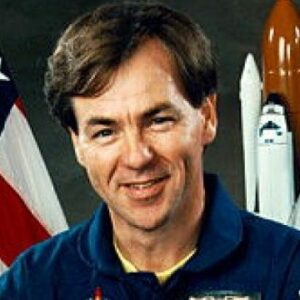Bjarni Tryggvason is a former Canadian Space Agency (CSA) astronaut who served as a Payload Specialist on STS-85, a mission to study changes in the Earth’s atmosphere. He has accumulated over 4,000 hours of flight time and has been a part of several significant space missions conducted by the Canadian Space Agency and the National Research Council (NRC). He was one of Canada’s original six astronauts and received training as a backup payload specialist for the CANEX-2 experiment set. He also served as the project engineer for Mission STS-52’s Space Vision System Target Spacecraft. He was born in Iceland, grew up in Vancouver, and began his career as a meteorologist with the Atmospheric Environment Service’s cloud physics group in Toronto. He began his association with the NRC when he joined Ottawa’s Low Speed Aerodynamics Laboratory. He designed and led aerodynamics tests as part of the NRC team investigating the sinking of the Ocean Ranger oil rig. Following this, he was chosen as one of Canada’s six astronauts. Prior to pursuing a career as an astronaut, he worked as a part-time lecturer teaching graduate courses on structural dynamics and random vibrations. He has returned to teaching now that he is retired.
Childhood & Adolescence
He was born in Reykjavk, Iceland, on 21 September 1945. He attended elementary school in Nova Scotia and British Columbia.
He attended high school in Richmond, British Columbia, and continued his education at the University of British Columbia. In 1972, he earned a Bachelor of Applied Science in Engineering Physics.
He later earned a postgraduate degree in engineering from the University of Western Ontario, with a concentration in applied mathematics and fluid dynamics.
Career of Bjarni Tryggvason
In 1972, he was hired as a meteorologist with the Atmospheric Environment Service’s cloud physics group in Toronto, where he worked until 1973.
He began his career at the University of Western Ontario in 1974 as a research associate at the University’s Boundary Layer Wind Tunnel Laboratory. He worked on projects involving the study of wind effects on structures using rigid and aeroelastic model studies.
He also began teaching as a guest research associate during this time period, first at Kyoto University in Japan and then at James Cook University in Townsville, Australia.
He returned to Western Ontario University in 1979 as a lecturer in applied mathematics, a position he held until 1982. He accepted an offer to join the National Research Council’s (NRC) Low Speed Aerodynamics Laboratory as a Research Officer after leaving this teaching position.
In 1981, he began teaching graduate courses in structural dynamics and random vibrations at the University of Ottawa and Carleton University on a part-time basis.
The Ocean Ranger oil rig sank in February 1982. He was a member of the National Research Council team that investigated the tragedy. Tryggvason designed and oversaw the aerodynamics tests that established the rig’s wind loads.
He was selected in December 1983 as one of the original six Canadian astronauts and trained as a backup payload specialist to Steve MacLean for the CANEX-2 set of experiments that flew on STS-52 from 22 October to 1 November 1992.
He was the Project Engineer for the Space Vision System (SVS) Target Spacecraft that was deployed on that mission.
He also served as principal investigator for several projects, including the development of the Large Motion Isolation Mount (LMIM), which flew numerous times on NASA KC-135 and DC-9 aircraft; the Microgravity Vibration Isolation Mount (MIM), which operated on the Russian space station Mir from April 1996 to January 1998 to support several Canadian and US material science and fluid physics experiments; and the MIM-2, which flew on STS-85 in August 1997.
He was instrumental in the early development phase of the Microgravity Vibration Isolation Subsystem (MVIS), which was developed by the Canadian Space Agency for the European Space Agency’s Fluid Science Laboratory (CSA).
In August 1997, he flew as a payload specialist aboard the Space Shuttle Discovery on Mission STS-85. On the 12-day mission to study changes in the Earth’s atmosphere, he tested MIM-2 and conducted fluid dynamics experiments to determine its sensitivity to spacecraft vibrations.
He attended a NASA mission specialist training session at the Johnson Space Center in Houston, Texas, designed to prepare astronauts for roles as mission specialists on the space shuttle and as potential crew members on the International Space Station.
*He left the CSA in 2001 and worked in the private sector until 2003. He returned to the CSA on a temporary basis in 2004 and retired in June 2008.
Significant Works of Bjarni Tryggvason
He was a member of the National Research Council team assembled to investigate the sinking of the Ocean Ranger oil rig. He designed and oversaw the aerodynamics tests that established the rig’s wind loads.
He worked as a Payload Specialist on STS-85 in 1997, a 12-day mission designed to study changes in the Earth’s atmosphere.
Awards and Accomplishments
In 1997, he was awarded the NASA Space Flight Medal.
In 1998, he was awarded an honorary doctorate by the University of Western Ontario, and in 2000 by the University of Iceland.
He is the proud recipient of three Innovators Awards from the Canadian Space Agency.
Personal History and Legacies
He was previously married to Lilyanna Zmijak, but the couple divorced. He is the father of two children: Michael Kristjan and Lauren Stephanie Chironne.
Estimated Net Worth
Bjarni is one of the wealthiest Astronauts and is included in the list of the most popular Astronauts. Bjarni Tryggvason’s net worth is estimated to be around $1.5 million, based on our analysis of Wikipedia, Forbes, and Business Insider.


